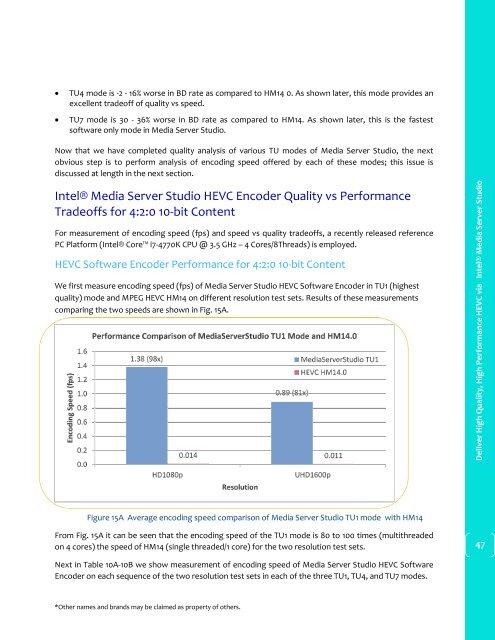You also want an ePaper? Increase the reach of your titles
YUMPU automatically turns print PDFs into web optimized ePapers that Google loves.
TU4 mode is -2 - 16% worse in BD rate as compared to HM14 0. As shown later, this mode provides an<br />
excellent tradeoff of quality vs speed.<br />
TU7 mode is 30 - 36% worse in BD rate as compared to HM14. As shown later, this is the fastest<br />
software only mode in <strong>Media</strong> <strong>Server</strong> <strong>Studio</strong>.<br />
Now that we have completed quality analysis of various TU modes of <strong>Media</strong> <strong>Server</strong> <strong>Studio</strong>, the next<br />
obvious step is to perform analysis of encoding speed offered by each of these modes; this issue is<br />
discussed at length in the next section.<br />
<strong>Intel®</strong> <strong>Media</strong> <strong>Server</strong> <strong>Studio</strong> <strong>HEVC</strong> Encoder <strong>Quality</strong> vs <strong>Performance</strong><br />
Tradeoffs for 4:2:0 10-bit Content<br />
For measurement of encoding speed (fps) and speed vs quality tradeoffs, a recently released reference<br />
PC Platform (<strong>Intel®</strong> Core i7-4770K CPU @ 3.5 GHz – 4 Cores/8Threads) is employed.<br />
<strong>HEVC</strong> Software Encoder <strong>Performance</strong> for 4:2:0 10-bit Content<br />
We first measure encoding speed (fps) of <strong>Media</strong> <strong>Server</strong> <strong>Studio</strong> <strong>HEVC</strong> Software Encoder in TU1 (highest<br />
quality) mode and MPEG <strong>HEVC</strong> HM14 on different resolution test sets. Results of these measurements<br />
comparing the two speeds are shown in Fig. 15A.<br />
Encoding Speed (fps)<br />
1.6<br />
1.4<br />
1.2<br />
1.0<br />
0.8<br />
0.6<br />
0.4<br />
0.2<br />
0.0<br />
<strong>Performance</strong> Comparison of <strong>Media</strong><strong>Server</strong><strong>Studio</strong> TU1 Mode and HM14.0<br />
1.38 (98x)<br />
HD1080p<br />
0.89 (81x)<br />
0.014 0.011<br />
Resolution<br />
<strong>Media</strong><strong>Server</strong><strong>Studio</strong> TU1<br />
<strong>HEVC</strong> HM14.0<br />
UHD1600p<br />
<strong>Deliver</strong> <strong>High</strong> <strong>Quality</strong>, <strong>High</strong> <strong>Performance</strong> <strong>HEVC</strong> <strong>via</strong> <strong>Intel®</strong> <strong>Media</strong> <strong>Server</strong> <strong>Studio</strong><br />
Figure 15A Average encoding speed comparison of <strong>Media</strong> <strong>Server</strong> <strong>Studio</strong> TU1 mode with HM14<br />
From Fig. 15A it can be seen that the encoding speed of the TU1 mode is 80 to 100 times (multithreaded<br />
on 4 cores) the speed of HM14 (single threaded/1 core) for the two resolution test sets.<br />
47<br />
Next in Table 10A-10B we show measurement of encoding speed of <strong>Media</strong> <strong>Server</strong> <strong>Studio</strong> <strong>HEVC</strong> Software<br />
Encoder on each sequence of the two resolution test sets in each of the three TU1, TU4, and TU7 modes.<br />
*Other names and brands may be claimed as property of others.


